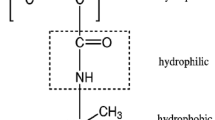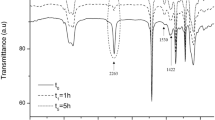Abstract
Three crosslinkers, poly(ethylene glycol) diacrylate (PEGDA), glycerol ethoxylate triacrylate (GETA) and citric acid-(PEG acrylate)3 (CA-PEGTA) derived from poly(ethylene glycol) (PEG) were synthesized at first. The three series of poly (N-isopropylacrylamide) (PNIPAAm) hydrogels were prepared by photopolymerization with the crosslinkers and compared with a hydrogel based on commercial crosslinker, N,N′-methylene bis-acrylamide (NMBA). The influence of the crosslinker structures and contents on the swelling behaviour, mechanical properties, and drug release of the hydrogels was investigated. The results showed that the hydrogels based on PEGDA and NMBA exhibited the highest and the lowest swelling ratio, respectively. The content of crosslinker of all hydrogel series showed good thermosensitivity and thermo-reversibility. The critical gel transition temperature (CGTT) appeared at 32 °C for the hydrogel based on NMBA, but appeared at about 34 °C for other hydrogels due to higher hydrophilicity of the crosslinker. In the mechanical properties, three-arms crosslinker GETA and CA-PEGTA led to higher mechanical strength than a linear crosslinker PEGDA. A hydrogel based on GETA (NG6) showed the highest shear modulus of 656.9 kPa and Young’s modulus of 1655.0 kPa. The hydrogels containing higher content of crosslinker revealed lower swelling ratio and higher mechanical strength. In the drug release, the hydrogels with higher swelling ratios showed higher drug absorbed. The highest release percentage of caffeine and vitamin B12 for hydrogel based on PEGDA (NP6) could reach 68.3% and 75.4%, respectively. In addition, the bound water and toxicity of the hydrogels were also investigated.








Similar content being viewed by others
References
Ahmed EM (2015) Hydrogel: preparation, characterization, and applications: a review. J Adv Res 6:105–121
Palmese LL, Thapa RK, Sullivan MO, Kiick KL (2019) Hybrid hydrogels for biomedical applications. Curr Opin Chem Eng 24:143–157
Vázquez-González M, Willner I (2019) Stimuli-responsive biomolecule-based hydrogels and their applications. Angew Chem. https://doi.org/10.1002/anie.201907670
Yang X, Wang K, Yan L, Yu Q, Xia H, Liu Y, Yan C (2019) Multi-stimuli-responsive poly(hydroxyethyl methacrylate-co-N-vinyl pyrrolidone-co-methacrylic acid-co-N-isopropylacryl amide) hydrogel: synthesis, characterization and application in drug release. Iran Polym J 28:957–967
Zhang YS, Khademhosseini A (2017) Advances in engineering hydrogels. Science 356:eaaf3627
Lanzalaco S, Armelin E (2017) Poly(N-isopropylacrylamide) and copolymers: a review on recent progresses in biomedical applications. Gels 3:36–67
Xu X, Liu Y, Fu W, Yao M, Ding Z, Xuan J, Li D, Wang S, Xia Y, Cao M (2020) Poly(N-isopropylacrylamide)-based thermoresponsive composite hydrogels for biomedical applications. Polymers 12:580–602
Wu SW, Liu X, Mille AL, Cheng YS, Yeh ML, Lu L (2018) Strengthening injectable thermo-sensitive NIPAAm-g-chitosan hydrogels using chemical cross-linking of disulfide bonds as scaffolds for tissue engineering. Carbohydr Polym 192:308–316
Wang Y, Yang N, Wang D, He Y, Chen L, Zhao Y (2018) Poly(MAH-β-cyclodextrin-co -NIPAAm) hydrogels with drug hosting and thermo/pH-sensitive for controlled drug release. Polym Degrad Stab 147:123–131
Liu J, An T, Chen Z, Wang Z, Zhou H, Fan T, Zhang D, Antonietti M (2017) Carbon nitride nanosheets as visible light photocatalytic initiators and crosslinkers for hydrogels with thermoresponsive turbidity. J Mater Chem A 5:8933–8938
Qu J, Zhao X, Liang Y, Zhang T, Ma PX, Guo B (2018) Antibacterial adhesive injectable hydrogels with rapid self-healing, extensibility and compressibility as wound dressing for joints skin wound healing. Biomaterials 183:185–199
Jiang H, Zhang G, Feng X, Liu H, Li F, Wang M, Li H (2017) Room-temperature self-healing tough nanocomposite hydrogel crosslinked by zirconium hydroxide nanoparticles. Compos Sci Technol 140:54–62
Jain P, Hung HC, Li B, Ma J, Dong D, Lin X, Sinclair A, Zhang P, O’Kelly MB, Niu L, Jiang S (2018) Zwitter ionic hydrogels based on a degradable disulfide carboxybetaine cross-linker. Langmuir 35:1864–1871
Hodgson SM, McNelles SA, Abdullahu L, Marozas IA, Anseth KS, Adronov A (2017) Reproducible dendronized PEG hydrogels via SPAAC cross-linking. Biomacromol 18:4054–4059
Iman M, Barati A, Safari S (2020) Characterization, in vitro antibacterial activity, and toxicity for rat of tetracycline in a nanocomposite hydrogel based on PEG and cellulose. Cellulose 27:347–356
Zhang Y, An D, Pardo Y, Chiu A, Song W, Liu Q, Zhou F, McDonough SP, Ma M (2017) High-water-content and resilient PEG-containing hydrogels with low fibrotic response. Acta Biomater 53:100–108
Zhang M, Song CC, Du FS, Li ZC (2017) Supersensitive oxidation-responsive biodegradable PEG hydrogels for glucose-triggered insulin delivery. ACS Appl Mater Interfaces 9:25905–25914
Deng H, Dong A, Song J, Chen X (2019) Injectable thermosensitive hydrogel systems based on functional PEG/PCL block polymer for local drug delivery. J Control Release 297:60–70
An H, Zhu L, Shen J, Li W, Wang Y, Qin J (2020) Self-healing PEG-poly(aspartic acid) hydrogel with rapid shape recovery and drug release. Colloids Surf B 185:110601
Wang P, Chu W, Zhuo X, Zhang Y, Gou J, Ren T, He H, Yin T, Tang X (2017) Modified PLGA–PEG–PLGA thermosensitive hydrogels with suitable thermosensitivity and properties for use in a drug delivery system. J Mater Chem B 5:1551–1565
Prince DA, Villamagna IJ, Hopkins CC, Bruyn JRD, Gillies ER (2019) Effect of drug loading on the properties of temperature-responsive polyester–poly(ethylene glycol)–polyester hydrogels. Polym Int 68:1074–1083
Saidi M, Dabbaghi A, Rahmani S (2019) Swelling and drug delivery kinetics of click-synthesized hydrogels based on various combinations of PEG and star-shaped PCL: influence of network parameters on swelling and release behavior. Polym Bull 2019:1–22
Philippon A, Tao JC, Tétard D, Degueil-Castaing M, Maillard B (1997) Macrocyclic ethers by free radical cyclizations. Synth Commun 27:2651–2682
Sager TP (1932) An esterification resin as a ground-joint lubricant. Ind Eng Chem Anal Ed 4:388–388
Kabra BG, Gehrke SH, Hwang ST, Ritschel WA (1991) Modification of the dynamic swelling behaviour of poly (2-hydroxyethyl methacrylate) in water. J Appl Polym Sci 42:2409–2416
Korsmeyer RW, Meerwall EW, Peppas NA (1986) Solute and penetrant diffusion in swellable polymers. II. verification of theoretical models. J Polym Sci Polym Phys Ed 24:409–434
Peppas NA, Franson NM (1983) The swelling interface number as a criterion for prediction of diffusional solute release mechanisms in swellable polymers. J Polym Sci Polym Phys Ed 21:983–997
Davidson CW, Peppas NA (1986) Solute and penetrant diffusion in swellable polymers: VI. The Deborah and swelling interface numbers as indicators of the order of biomolecular release. J Controlled Release 3:259–271
Peppas NA, Barr-Howell BD (1986) Hydrogels in medicine and pharmacy. CRC Press, Boca Raton
Treloar LRG (1975) The physics of rubber elasticity. Clarendon, Oxford
Alfrey JRT, Gurnee EF, Lloyd WG (1966) Diffusion in glassy polymers. J Polym Sci Part C 12:249–261
Hoogenboom R (2014) Temperature-responsive polymers: properties, synthesis and applications. Smart Polym Appl 2:15–44
Vanparijs N, Nuhn L, De Geest BG (2017) Transiently thermoresponsive polymers and their applications in biomedicine. Chem Soc Rev 46:1193–1239
Song Y, Wang L, Gyanda R, Sakhuja R, Cavallaro M, Jackson DC, Meher NK, Ciaramitaro DA, Bedford CD, Katritzky AR, Duran RS (2010) Effect of the crosslink functionality on the mechanical properties of crosslinked 1,2,3-triazole polymers as potential binders for rocket propellants. J Appl Polym Sci 117:473–478
Lee WF, Wu RJ (1997) Superabsorbent polymeric materials. II. swelling behaviour of crosslinked poly[sodium acrylate-co-3-dimethyl (methacryloyloxyethyl) ammonium propanesulfonate] in aqueous salt solution. J Appl Polym Sci 64:1701–1712
Acknowledgements
The authors thank the Ministry of Science and Technology of the Republic of China for support under Grant MOST103-2221-E-036-037- and Tatung University for their financial support under Grant B103-C01-005
Author information
Authors and Affiliations
Corresponding author
Electronic supplementary material
Below is the link to the electronic supplementary material.
Rights and permissions
About this article
Cite this article
Wu, WX., Huang, YC. & Lee, WF. Effect of poly(ethylene glycol)-derived crosslinkers on the properties of thermosensitive hydrogels. Iran Polym J 29, 679–691 (2020). https://doi.org/10.1007/s13726-020-00831-7
Received:
Accepted:
Published:
Issue Date:
DOI: https://doi.org/10.1007/s13726-020-00831-7




